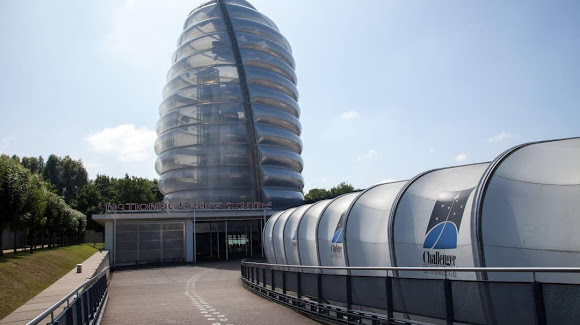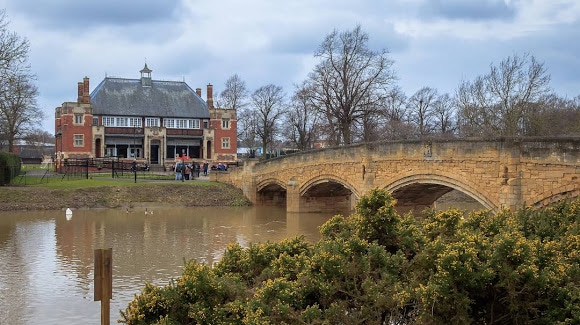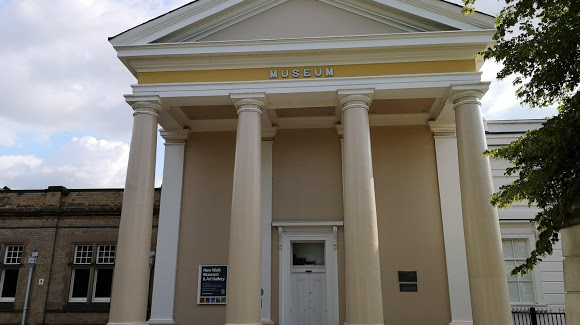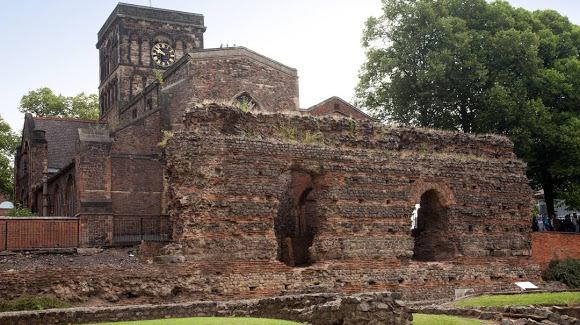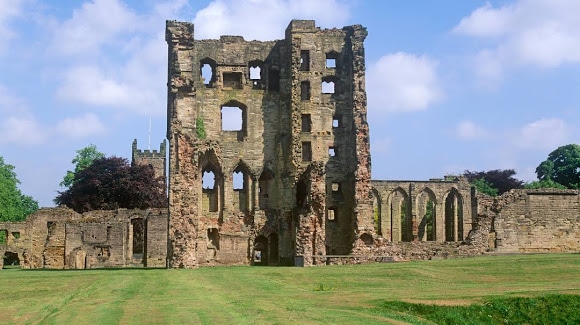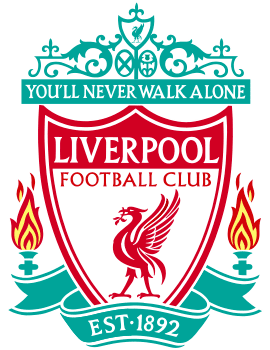Leicester City FC Tryouts & Club Guide: History, Stadium, Players, and More!

Welcome!
Discover the world of soccer with fcscout.com, your go-to scout for club tryout information, club guides, player profiles, in-depth product reviews, and more. We’re dedicated to exploring and revealing the best in each domain, empowering you with knowledge to make informed choices.
Thank you for being here!
Hi, I’m Carlos! A coach, sports enthusiast, and the founder of FCScout.com.
I fell in love with the game at a very young age like many of you. I’ve been following and playing soccer for many years.
Throughout my career, I always enjoyed helping soccer players chase their dreams, which is why I started this website. I wanted to reach a larger audience outside of my local area and fcscout.com was born.
This website is a platform I will be using to update club pages on any tryouts, stadiums, players, tech, and more from clubs around the world. I also create free recruitment profiles for players looking to have that extra competitive edge when reaching out to clubs.
That’s it. That’s my pitch for you to stick around (or browse the site as you please).
This is already too much text for a “see more” drop-down button thing. If you want to reach out to me, head on over to my contact page 🙂

Leicester City Football Club is a professional football club based in Leicester in the East Midlands, England. The club competes in the Premier League, the top division of England’s football league system.
Leicester City FC Youth Development System
Leicester City F.C. Academy are the youth team of Leicester City directed by Jon Rudkin and managed by Adam Barradell. Leicester City’s academy has had category one status under the Elite Player Performance Plan since July 2013.
Leicester City F.C. Academy
Leicester City Football Club’s Academy is committed in its endeavour to identify talented young players and to provide quality coaching, combined with a relevant education package in order to produce young men of integrity with the ability to play professional football at Premier League and Football League level.

Through our player-centered focus and the implementation of our ‘Committed to Excellence’ technical programme, we are fully committed to providing a top-quality experience to all of our players aged between eight and 21-years-old, in order to provide the best chance of eventually making the First Team at Leicester City.
With the continued support from the Board of Directors and senior management at the Club, we are fiercely proud of what has been achieved so far at Leicester City and we look forward to challenging ourselves to maintain and improve upon those already high standards.
Leicester City FC Academy Player Registration
All players between the ages of nine to 11 years-old must reside within one hour’s travelling time of the Academy. Prospective players aged Under-12 to Under-16 must live within one and a half hour’s travelling time of the Club.
During each individual players’ time with the Club, both the individuals and their parents will be required to comply with the Academy rules and regulations. At the end of the specified trial period, the player and their parents will be informed as to whether their trial period has been successful.

If unsuccessful, the player will be given a full appraisal by our coaches to advise of areas that could be improved to aid future development.
A player aged between nine and 16 years-old may sign with the Academy for one, two or four years dependent on age group. At the end of the time period the player will be informed whether the Club wish to retain or release them.
The Academy will operate in accordance with the Elite Player Performance Plan (EPPP) regulations as set out by both the Government and the FA ensuring that all criteria are met across the entire registration and recruitment process.
For more information on our scouting network and development centres contact Bill Wall by calling 0116 222 8536.
For further information and to learn more, please visit their contact page by clicking here.
Leicester City Under-23s
Leicester City Under-23s are the former reserve team of Leicester City. The team mainly consists of under-23 players at the club, although senior players occasionally play in the reserve side, for instance when they are recovering from injury. The Under-23s team are managed by Steve Beaglehole and they play in Premier League 2.
To learn more about their U-23 team, please click here.
EXPLORE MORE CLUBS!
Explore more professional clubs by continent.
Leicester City FC Overview
Leicester City Football Club is a professional football club based in Leicester in the East Midlands, England. The club competes in the Premier League, the top division of England’s football league system, and plays its home matches at the King Power Stadium.

Leicester Fosse F.C. was established in 1884 on a field near Fosse Road as the city’s first football team. They moved to Filbert Street in 1891, were admitted to the Football League in 1894, and took on the name Leicester City in 1919 after winning promotion to the league. King Power Stadium (King Power Stadium) was established in 2011 after the team moved to Walkers Stadium (Walkers) from 2002 to 2002. Leicester City won the Premier League for the first time in 2015–16. As a club founded in 1992, they are one of just seven to have won the Premier League title. Multiple bookmakers had never paid out at such high odds for any sport before to Leicester’s title win, according to a number of media. This led to the team being called “The Unbelievables,” a nod to Arsenal’s legendary “Invincibles” squad. The club’s previous best result was a runner-up spot in the First Division in 1928–29.
Leicester City FC History
Founding and early years (1884–1949)
“Leicester Fosse” was founded in 1884 by a group of former students of Wyggeston School and became an FA member in 1890. Until 1891, the club had played at five different locations, including Victoria Park in the city’s southeast and the Belgrave Road Cycle and Cricket Ground in the city’s northwest. The team joined the Midland League in 1891 and was elected to the Football League’s Division Two in 1894, placing second in the league. Leicester’s first Football League encounter ended in a 4–3 loss to Grimsby Town, but the following week, they beat Rotherham United at Filbert Street for their first league victory. 13–0 thrashing of non-league Notts Olympic in an FA Cup qualifying match was the club’s biggest win to date. During the 1907–08 season, the team finished second in the Second Division and was promoted to England’s top division, the First Division. As a result of their record defeat to Nottingham Forest (12–0), the team was relegated after only one season.
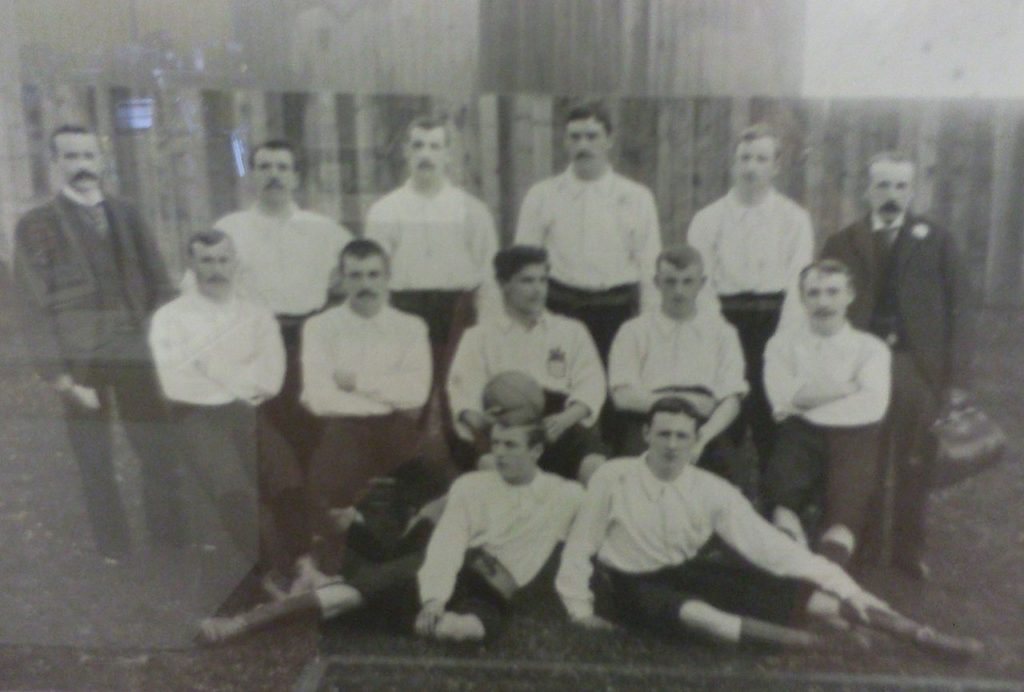
Leicester Fosse went out of business in 1919, when the League returned after World War I, due to unknown financial troubles. The name “Leicester City Football Club” was given to the team in honor of the city status that the borough of Leicester had just received. After the name change, the club had some success in the 1920s, winning the Division Two title in 1924–25 and finishing second in the league in 1928–29, both with record goal scorer Arthur Chandler in the team. Although the club was relegated in 1934–35 and promoted in 1936–37, another relegation in 1938–39 would leave them in Division Two at the end of the decade.
Post-World War II (1949–2000)
At this year’s FA Cup final, Wolverhampton Wanderers defeated City 3–1. They were rejoicing, however, a week later when their final-day tie kept them in Division Two. Arthur Rowley, one of Leicester’s most prolific attackers, helped the team win the Division Two championship in 1954. When Dave Halliday took over in 1957, they were relegated from the first flight, but Rowley set a club record of 44 goals in one season. Until 1969, Leicester was the only team to play in Division One for an extended period of time. Leicester City made it to the FA Cup final on two more occasions, both times losing, under Matt Gillies and his assistant Bert Johnson. They represented England in the 1961–62 European Cup Champions’ Cup after losing to Tottenham Hotspur, the 1961–62 double winners. Due to a remarkable run of form on cold and frozen pitches in the 1962–63 season, the team was nicknamed the “Ice Kings” and eventually finished fourth, their greatest postwar performance. In the summer of 1963, the club was fourth. When Leicester beat Stoke City 4–3 on aggregate in 1964 to win the League Cup for the first time, Gillies was in charge. The next year, Leicester also made it to the League Cup final, where they were defeated by Chelsea in three games, 3–2. The “spin” and “switch” strategy, utilized earlier by the Austrian and Hungarian national teams, was praised by Gillies and Johnson. Resignation came after a poor start to the season for Matt Gillies in November 1968. Even though Frank O’Farrell, his replacement, was unable to keep the team from being relegated, they made it to the FA Cup final in 1969, when they lost to Manchester City 1–0.
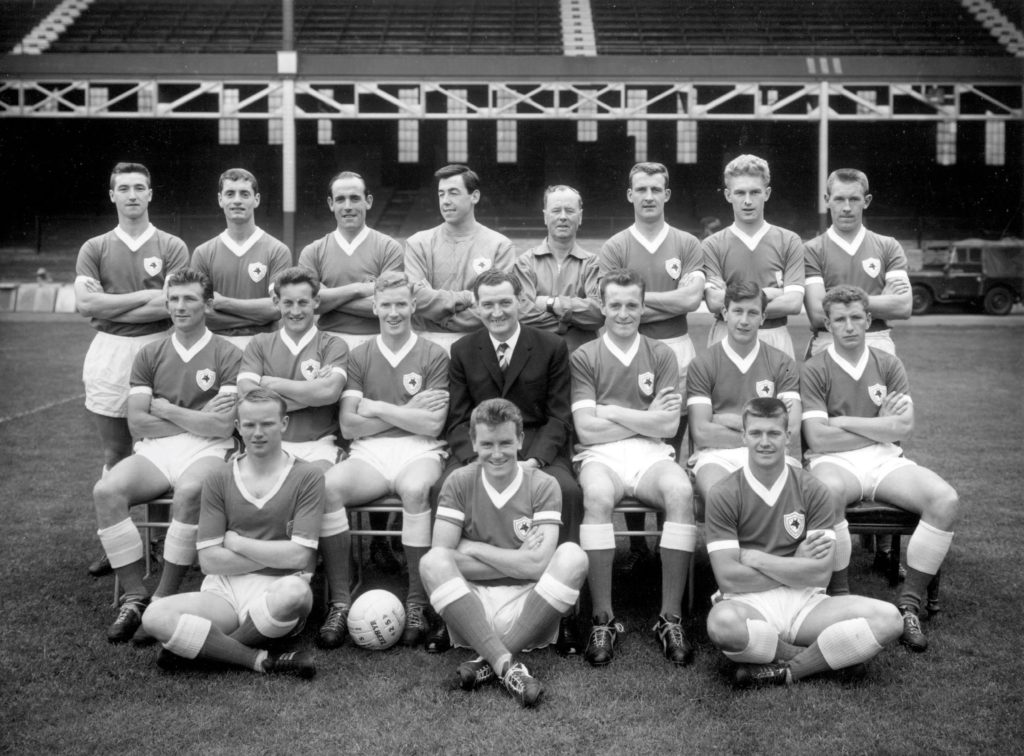
As a result of their return to Division One in 1971, Leicester City won the Charity Shield for the first time. The double winners Arsenal were unable to meet their FA Cup semifinalists Liverpool because of their European commitments, instead the Division Two champions Leicester were given the opportunity to take on the FA Cup runners-up. Leicester defeated Liverpool 1–0 thanks to a goal from Steve Whitworth. After Jimmy Bloomfield took over as manager, his team remained in the First Division all season under his guidance. There have never been so many years in which the team has been in the top flight. In 1973–74, Leicester City made it all the way to the FA Cup semi-finals. Frank McLintock, a notable Leicester player for seven years from the late Fifties to the mid Sixties, took up Jimmy Bloomfield’s position in 1977. McLintock resigned after City were relegated at the end of the 1977–78 season. After Peter Hodge and Matt Gillies, successful Scottish managers, Jock Wallace led Leicester City to the Division Two Championship in 1980. In 1982, despite Wallace’s inability to retain Leicester in Division One, they reached the semi-finals of the FA Cup. Gary Lineker, one of Manchester City’s best-known homegrown players, made his debut in the first team under Wallace. Gordon Milne was promoted to manager of Leicester in 1983. Leicester were relegated two years after selling Lineker to Everton because they couldn’t find a suitable successor for Alan Smith, who was sold to Arsenal after Leicester were relegated.
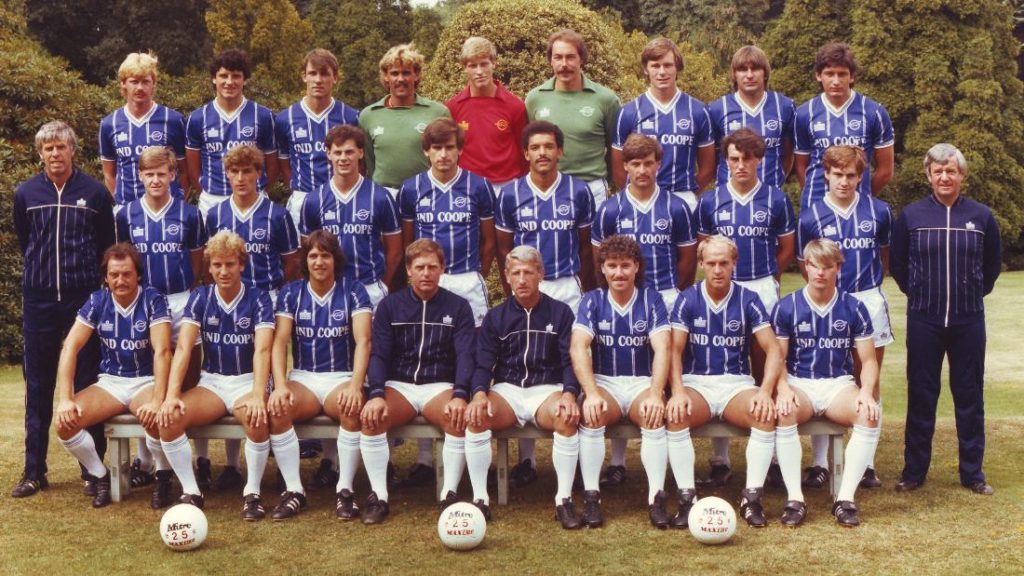
Leicester were in danger of relegation in January 1991 when David Pleat took over as manager after Milne left in 1986. The club appointed Gordon Lee as interim manager till the end of the season. When Leicester City won their final game of the season, they avoided being relegated to the second division of English football. Before taking over in 1991, Brian Little led Leicester to a playoff final appearance before losing to Blackburn Rovers and a penalty from former Leicester scorer Mike Newell in the new FA Premier League in 1991–92. The next year, the team made it all the way to the playoff final before falling to Swindon Town 4–3, despite coming back from a 3–0 deficit. They were promoted from the playoffs in 1993–94 after defeating Derby County 2–1. Mark McGhee was unable to prevent Leicester from a second-place finish in the 1994–95 season after taking over as manager following Little’s departure to Aston Villa in November of that year. In December 1995, although Leicester were top of the First Division, McGhee abruptly departed the club to become manager of Wolverhampton Wanderers. Martin O’Neill replaced McGhee. Steve Claridge’s 120th-minute goal gave Leicester a 2–1 victory against Crystal Palace in the 1996 Football League play-off final and promotion to the FA Premier League. Leicester became a mainstay in the Premier League after their promotion, finishing in the top ten four times in a row. When O’Neill won the League Cup twice in 1997 and 2000, he broke Leicester City’s 33-year trophy drought. As a result, in 1997–98 and 2000–01, the club qualified for the UEFA Cup, its first European competition since 1961. O’Neill was appointed manager of Celtic in June 2000, after leaving Leicester City.
Decline in the early 21st century (2000–2008)
Former England under-21 coach Peter Taylor has taken over for O’Neill. On September 28, 2000, Leicester’s UEFA Cup match against Red Star Belgrade concluded in a 3–1 defeat. During the first two weeks of October, Leicester topped the Premier League and remained in contention for a European spot, but a late-season slump took them down to a 13th place finish. For six months, Dave Bassett was in charge before he was replaced by assistant Micky Adams. The change of leadership came just days after the club was officially relegated under Taylor’s leadership in 2001–02.
Leicester only managed to win five of their league games. At the start of the 2002–03 season, Leicester relocated into the new 32,314-seat Walkers Stadium, ending 111 years at Filbert Street. For a period of 10 years, Walkers, a crisp manufacturer located in Leicestershire, obtained the naming rights to the event. The club’s debts were £30 million when it filed for bankruptcy in October 2002.
Because ITV Digital was in administration and had pledged money to First Division clubs for their TV rights, the enormous wage bill, lower than projected earnings for players who were transferred to other clubs, and the £37 million cost of a new stadium were all contributing factors. Even after the club was saved by a consortium led by Gary Lineker and taken control, Adams was banned from the transfer market for the majority of the season. Adams led Leicester to second place in Division One and promotion to the Premier League with more than 90 points. As a result, Leicester were demoted to the newly-named Championship, previously known as Division One, after one season.
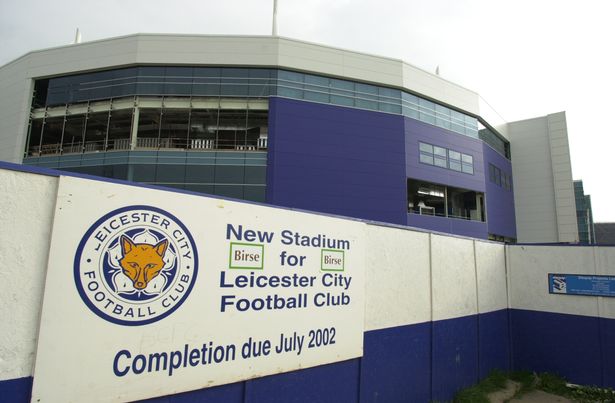
Craig Levein was appointed manager after Adams quit in October 2004. After 15 months in charge, Levein was fired for failing to move the Foxes anywhere near the promotion positions. This proved to be a dismal period. Rob Kelly, the team’s assistant manager, took over as caretaker manager and won three of the four games he took charge of. Kelly guided Leicester to safety and was promoted to manager on a permanent basis in April of that year. Ex-Portsmouth chairman Milan Mandari was quoted in October 2006 as indicating he was interested in buying the club for around £6 million, with the present playing team valued at approximately £4.2 million.
On February 13, 2007, the acquisition was formally disclosed. Rob Kelly was fired as manager on April 11th, 2007, and Nigel Worthington was named caretaker manager for the remainder of the season. It was Worthington who saved the team from relegation, although he was not given the post on a regular basis. It was announced on May 25th, 2007 that former Milton Keynes Dons manager Martin Allen has signed a three-year contract with the club. Allen and Mandari’s relationship deteriorated after just four matches, and the two parted ways on August 29, 2007. Garry Megson was named as the new manager by Mandari on September 13, 2007, citing Megson’s “depth of experience” as a consideration in his selection. Bolton Wanderers made an approach for Megson’s services on October 24, 2007, after just six weeks in command. Frank Burrows and Gerry Taggart split the role of caretaker managers until a full-time manager was hired, Mandari stated.
Ian Holloway was appointed manager of Leicester City on November 22nd, and he won his first league match in charge by a score of 2–0 against Bristol City, becoming the club’s first manager to do so in more than 50 years. In the end, Leicester’s success was short-lived, and the team was relegated from the Championship at season’s conclusion in 2007-2008. Nigel Pearson was brought in as Holloway’s replacement after less than a season with the club.
Third tier to Premier League and takeover (2008–2015)
Leicester City’s first season outside of the top two tiers of English football was in 2008-09, but they only fell to this level seven years later before winning the Premier League title in 2015-16 – the fastest rise to the top of the English football league system since Ipswich Town in 1962 was also seven years. After being relegated to League One the season before, Leicester City returned to the Championship in 2008–09, winning League One after a 2–0 victory against Southend United.
During the 2009–10 Championship season, Nigel Pearson’s Leicester side finished fifth and advanced to the play-offs, their first season back at the second tier level under Pearson’s management. Even though they rallied from a 2-0 deficit to take a 3-2 lead in the play-off semifinal against Cardiff City, they ultimately fell short in a penalty shootout. Paulo Sousa had been a guest of the club for both play-off games, implying that he was being considered as a possible replacement for Pearson, who left Leicester at the end of the season. Sousa was confirmed as Pearson’s successor on July 7, 2010.

Thai-led consortium Asian Football Investments (AFI), headed by King Power Group’s Vichai Srivaddhanaprabha, bought Mandari in August 2010 following a three-year jersey sponsorship arrangement with duty-free retailers the King Power Group. AFI investor Mandari was retained as chairman of the board. In the wake of Leicester City’s dismal start to the 2010-11 season, Paulo Sousa was fired as the club’s manager on October 1, 2010, with immediate effect. Later, Sven-Göran Eriksson, who had been a target of Portsmouth after their 6–1 defeat two weeks earlier, was appointed as his replacement and signed a two-year contract with the team. New chairman Vichai Raksraaksorn was appointed on February 10th, 2011, following the departure of former chairman Mandari in November to take over Sheffield Wednesday.
After a shaky start in which the Foxes won just five of their first 13 games, Eriksson agreed to leave the club on October 24, 2011, putting their promotion hopes at risk. Nigel Pearson returned to the club three weeks later as Eriksson’s replacement. During the 2012–13 season, Pearson guided the Foxes to a sixth-place finish, securing their place in the Championship play-offs. After a late penalty miss by Anthony Knockaert and a late goal by Troy Deeney following a quick counterattack after a Manuel Almunia double save, Leicester lost 3–2 on aggregate to Watford in the playoff semi-final. It was in 2014 when Leicester’s ascent through the league system reached a tipping point. Premier League promotion for Leicester City was secured thanks to a 2–1 win against Sheffield Wednesday and defeats for QPR and Derby County. The following month, Leicester City beat Bolton 1-0 to win the 2013–14 Championship, their sixth title in the English second tier.
With a 2–2 draw against Everton on the first day of the season, Leicester had a promising start to their first season back in the Premier League since 2004. Leicester City then won their first Premier League game since May 2004 by defeating Stoke City 0-1 at the Britannia Stadium. Leicester City defeated Manchester United 5-3 at the King Power Stadium on September 21, 2014, after coming back from a 3-1 deficit with 30 minutes left to score four goals. It was one of the greatest comebacks in Premier League history. For the first time since the Premier League’s inception in 1992, they defeated Manchester United after falling down by two goals.
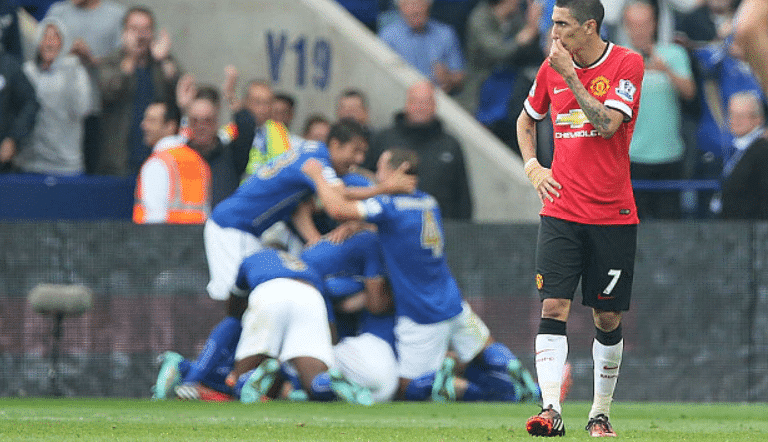
With only 19 points earned from 29 games last season, the squad was at its lowest point total since the 2013–14 season. They were seven points behind the pace by the 3rd of April in 2015. Leicester’s seven-year rise to the top of the Premier League may have come to an abrupt halt had they not won seven of their final nine league games, finishing the season in 14th position with 41 points. Queens Park Rangers, the team they beat to be relegated, lost 5–1. It was hailed as one of the greatest relegation escapes in Premier League history. A team with fewer than 20 points from 29 games had never before made it through the holiday season without relegation in the Premier League’s history (the other two were West Bromwich Albion in 2005 and Sunderland in 2014).
Premier League Champions (2015–16)
As the club put it, “The working relationship between Nigel and the Board is no longer feasible,” Pearson was fired on June 30, 2015. James Pearson, the son of former Leicester manager Nigel Pearson, was one of three Leicester reserve players who filmed a “racist sex tape” in Thailand during a post-season goodwill trip, which was the final straw in Pearson’s dismissal. The Foxes’ response was to hire Claudio Ranieri, a former Chelsea manager, as their new manager for the upcoming 2015–16 Premier League campaign. However, despite some initial misgivings, the team had an excellent start to the season. Jamie Vardy broke Ruud van Nistelrooy’s Premier League goal-scoring record by scoring 13 times in 11 straight games from August to November. At Goodison Park on December 19th, Leicester City overcame Everton 3–2 to take the top spot in the Premier League on Christmas Day, exactly one year after being bottom. When Leicester City beat Sunderland 2–0 on April 10, they qualified for the Champions League for the first time in their history thanks to Tottenham Hotspur’s 3–0 win against Manchester United.

At Stamford Bridge, Chelsea and Tottenham fought back to draw 2–2 and Leicester City won the Premier League on May 2, 2016. Except for Ipswich Town, this was the fastest seven-year ascent to the title. As implausible as a Leicester triumph seemed to the bookmakers before the season began, Ladbrokes and William Hill both offered odds of 5,000 to 1. Neither bookmaker had ever paid out such long odds, and the trophy resulted in the highest payout in British sporting history, with total prizes of £25 million. This was a huge coup for the club and for Leicester City as a whole. According to The Economist, “management lessons” would be gleaned from it. Several pundits see it as a model for other clubs of a similar size in English football, as well as a paradigm shift in expectations for such clubs.
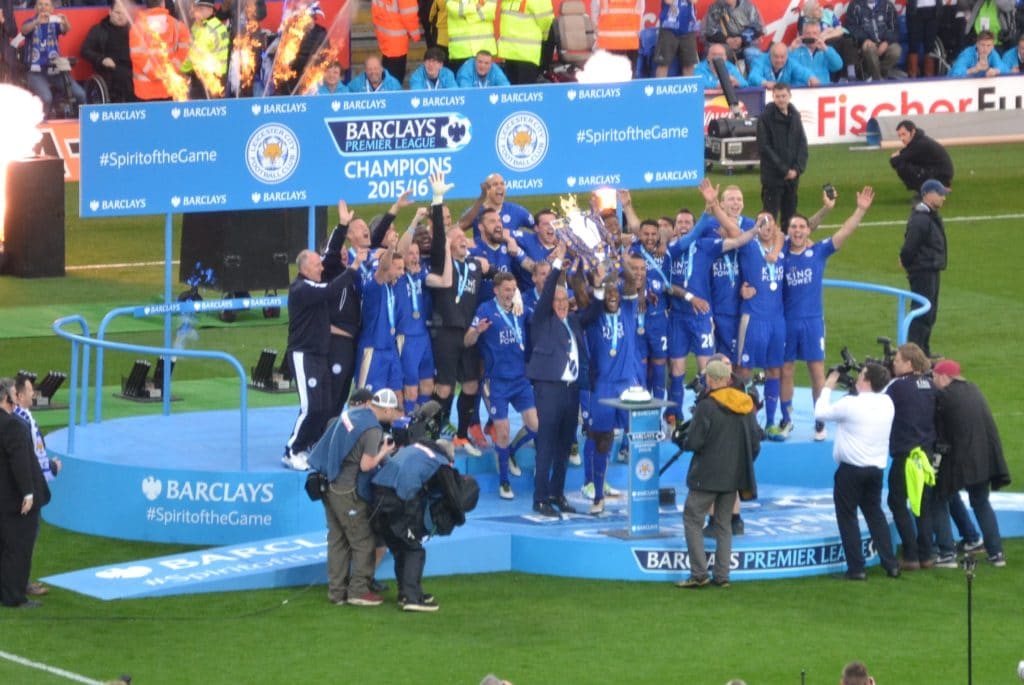
Due to their “amazing pace” and defensive unity, Leicester became well-known for their counterattacking style of play. Nigel Pearson, Leicester’s former manager, was widely regarded as having set the groundwork for the club’s title-winning season. The team’s work ethic and camaraderie were frequently lauded by teammates. Ex-executive chairman Richard Scudamore reacted to City’s Premier League triumph by saying:
If this was a once in every 5,000-year event, then we’ve effectively got another 5,000 years of hope ahead of us.
A film has been planned of the story, centered on Jamie Vardy.
Colors and Crest
For the most part, the team’s uniforms have consisted of royal blue shirts, white shorts, and either white or royal blue socks as the club’s home colors.
“The Foxes” is the most common nickname for the club. An image of a fox was first incorporated into the club crest in 1948, as Leicestershire is known for foxes and fox hunting.[86] This is the origin of the nickname “The Foxes”.
“Filbert Fox” is the mascot of the club. “Vickie Vixen” and “Cousin Dennis” are two other minor characters. As with Leicester City’s coat of arms, the emblem has a fox’s head placed over a Cinquefoil since its inception in 1992. Fosse’s home and away kits for the 2009–10 season featured no sponsors and a central crest with “125 Years” written beneath it; while the away colors were a return to Fosse’s original jersey, albeit with black shorts instead of the original white.
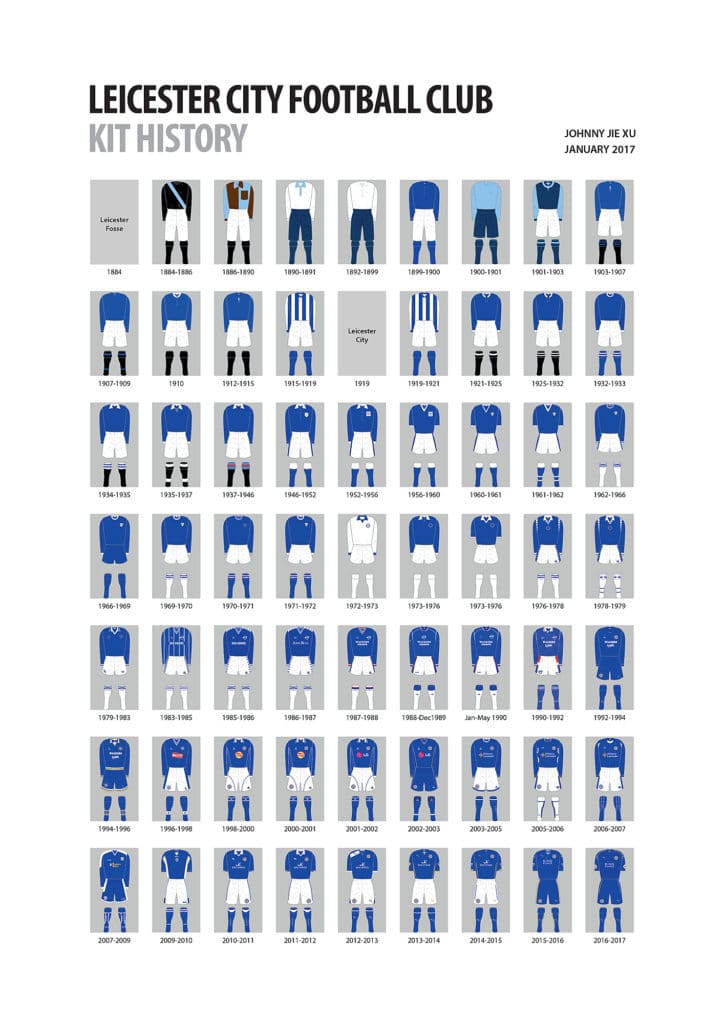
Prior to home matches, the Post Horn Galop was introduced in 1941. At all home games, it was played on the PA system as the teams emerged from the tunnel. There is now an updated version of the game that is played when the teams come out for the second half. First half of the post horn has been played by Paul Hing since 2009, live and on pitch. The club’s motto, “Foxes Never Quit,” is displayed over the tunnel entrance before each game.
The 2016–17 Premier League third kit was unveiled on July 8th, 2016. As part of their UEFA Champions League campaign in 2016–17 and Leicester’s first match in the competition, it was used for the match Incorporating narrow blue pinstripes on the shirt, as well as a textured, form-fitting stripe across the shirt and shorts, this year’s uniform was inspired by the 1983–84 home kit.
Leicester City FC Stadium
Leicester has only played at two stadiums since joining the Football League, compared to their previous ten. Leicester Fosse was the name given to the team when they initially began playing on a field near the Fosse Road. They later relocated to Victoria Park and then Belgrave Road after leaving there. The club relocated to Mill Lane when it turned professional. After being kicked out of Mill Lane, the club temporarily relocated to the County Cricket ground while they looked for a new home for their team. In 1891, the club moved to an area of land near Filbert Street after securing the use of the land.
A new two-tiered structure, known as the Double Decker, was built in 1927 by famed football architect Archibald Leitch and would bear that name until it was demolished in 2002. It wasn’t until 1993 that construction began on the new Carling Stand that the ground was improved beyond the addition of mandatory seats. Martin O’Neill said he used to “guide new recruits out backwards” so they could only see the Carling Stand because the remainder of the ground had not been renovated since at least the 1920s.
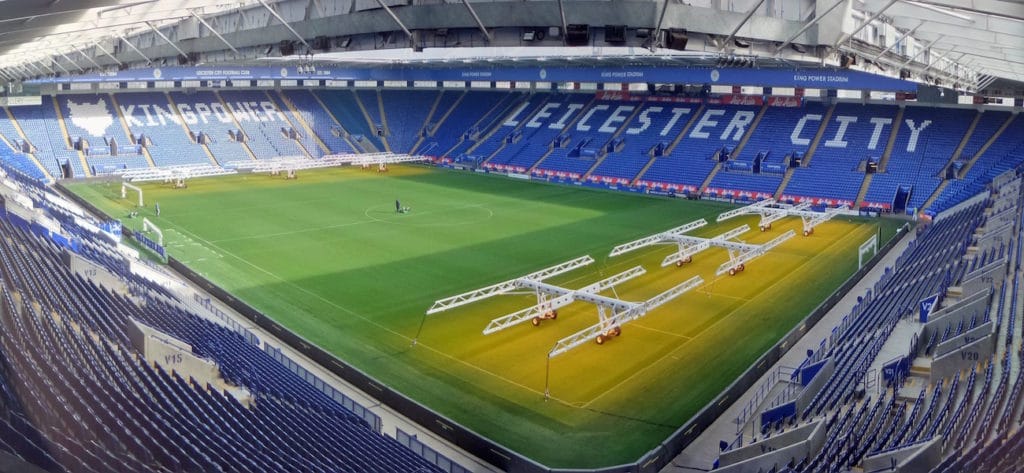
Moving from Filbert Street to a new 32,500 all-seater stadium was completed in 2002. There was an agreement with Walkers to rename the stadium The Walkers Stadium, and their emblem can still be seen in several places of the stadium’s exterior. Athletic Bilbao drew 1–1 in a friendly encounter at Walkers, with Bilbao’s Tiko scoring the opening goal and Leicester’s Jordan Stewart netting the first goal. The victory over Watford, in the team’s debut encounter, was a 2–0 triumph. Since then, the stadium has played host to a 2–1 victory for England against Serbia and Montenegro, as well as matches between Brazil and Jamaica and Ghana and Jamaica. The Leicester Tigers rugby club, which plays its home games at the King Power Venue, hosted the Heineken Cup European Rugby Semifinals in the stadium.
New owners King Power said on August 19 that they wished to rename the stadium to the King Power Stadium and boost its seating capacity to 42,000 if Leicester City won the Premier League. At an official press conference, Leicester City announced that the Walkers Stadium would become the King Power Stadium effective July 5, 2011. A new, state-of-the-art training complex will replace the club’s present training ground, Belvoir Drive, which was announced in 2018. The new training facility is expected to “challenge the very finest in Europe” when it is finished. It’s one of two major projects that Leicester City is now working on as part of the club’s King Power Stadium development plans.
City of Leicester, England
Leicester is the county town of Leicestershire and the unitary authority area of Leicester in the East Midlands of England. On the banks of the Soar River, just east of the eastern terminus of the National Forest, is the city of Soar. Nottingham, Peterborough, the city of Birmingham and Coventry are all within a reasonable driving distance, as are several smaller towns.
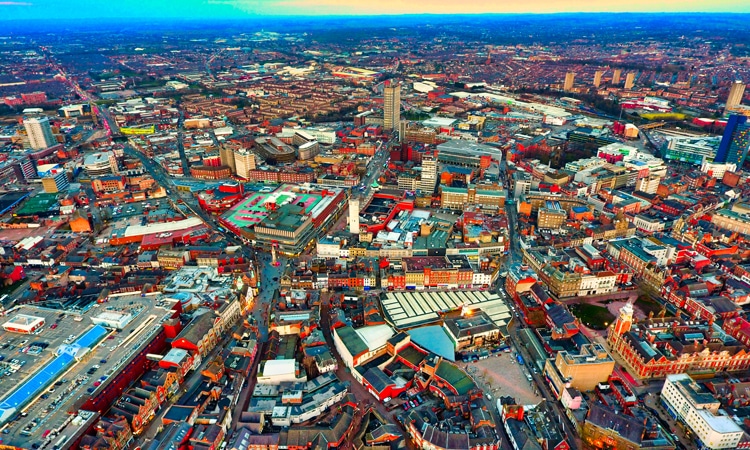
With a mid-year population estimate of 348,300, the City of Leicester unitary authority now has the most people in the East Midlands, up from a 2011 census count of 329,839 (an increase of around 18,500, or 5.6%). The connected urban area is also the 11th-largest in England and the 13th-largest in the United Kingdom in terms of population density.
Geography
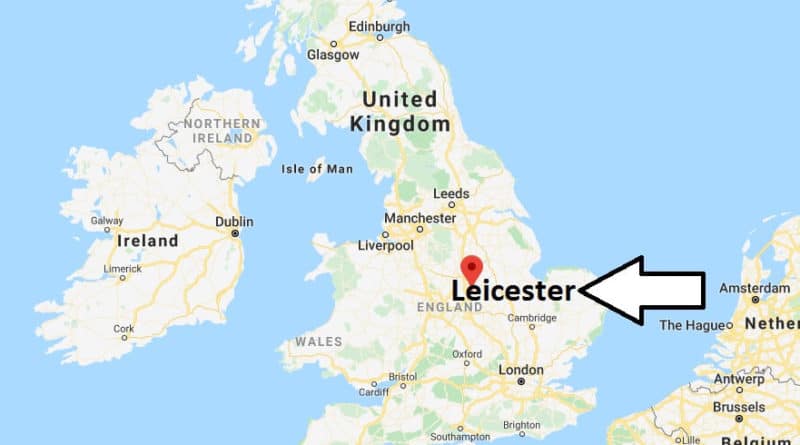
Climate
Summers are mild to warm and winters are mild to cold, with a lot of rain falling throughout the year. Newtown Linford, an official weather station located about eight kilometers (five miles) northwest of Leicester’s city center and on the outskirts of the urban area, was the closest one to the city. However, in 2003, observations were halted. Market Bosworth, about 10 miles west of the city center, is now the closest weather station.
A temperature of 35.1 °C (95.2 °F) was recorded at Leicester University in August 2003, however the highest temperature was recorded in Newtown Linford in August 1990 at 34.5 °C (94.1 °F). Despite this, the hottest temperature ever recorded in Leicester was 98.1 degrees Fahrenheit on July 15, 1868, when the mercury hit 36.7 degrees Celsius. The average annual maximum temperature is 28.7 °C (83.7 °F), which is more usual. At least 11.3 days of the year should be over 25.1 °C (77.2 °F) in temperature.

A temperature of 16.1°C (3.0°F) was recorded at Newtown Linford in January 1963. There are on average 54.9 air frosts in the United States each year. It rains 1 millimeter or more on an average of 120.8 of the year’s 684.4 millimeters (mm). The years 1971–2000 are used to calculate all averages.
Leicester City Lifestyle
